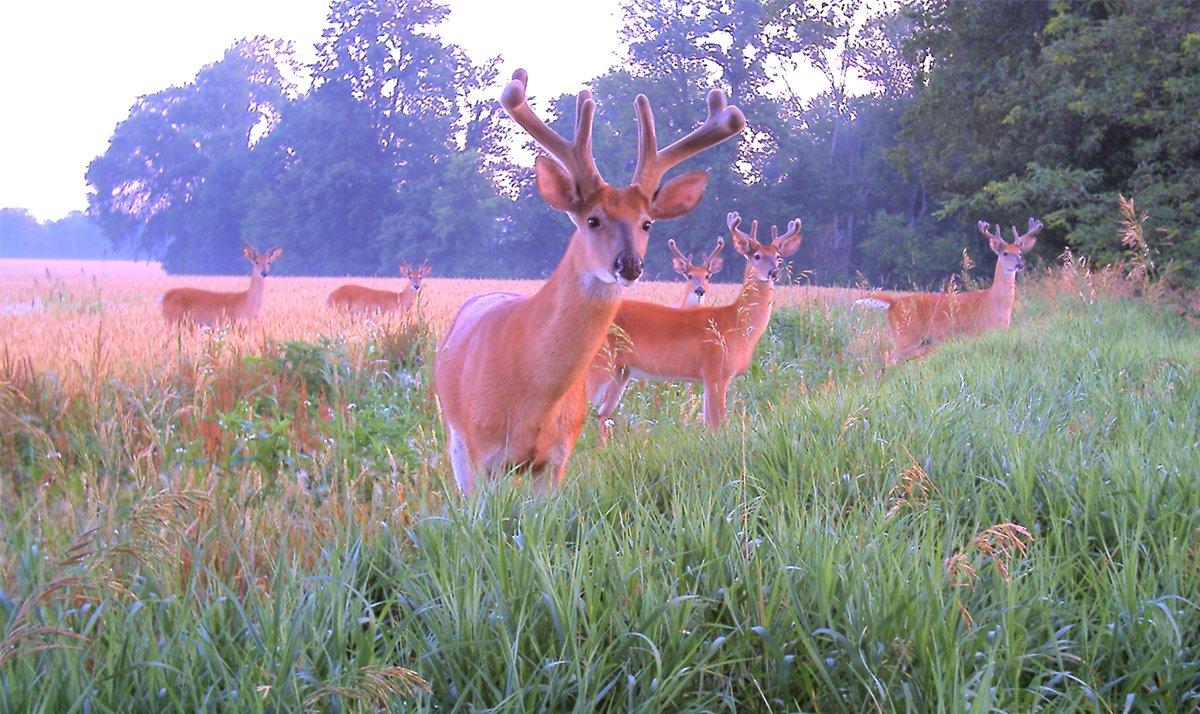Scout velvet bucks now and you might shoot the biggest one in the club in a few months
These soft, summer evenings in mid-July and August are when I officially start my scouting for the upcoming deer season.
A couple hours before dark, I drive to one of my hunt areas and park where I can see a good piece into a field of low-growing alfalfa, soybeans, clover, or a recently hayed pasture.
In a more heavily wooded habitat, I find a spot with a decent long view of a clear-cut, power line or similar opening in the timber.
Once I've obtained a vantage, I break out my 10X binocular and a spotting scope on a tripod, and look for velvet-racked bucks that gather to feed and posture out in the open at dusk. These bachelor clubs, which come together for only a few months each summer, are fun to watch, and their behavior is interesting and telling.
(Don't Miss: Prep Now For Your Best Deer Season Yet)
Club Size
Three to four to eight bucks hanging out together is pretty typical, but I have seen as many as 10 boys in a summer group. Knowing how much I love to watch and study bachelor clubs, hunters from all over have emailed me with reports (and pictures) of 15 to 19 bucks posturing together in a field. Last year, a guy from Maryland reported seeing 30 different bucks in a huge soybean field most every night!
Truth is, these mega-groups are rare. Big numbers of bucks are actually two, three or more different bachelor groups that happen to come together and loosely comingle.
Groups are comprised of bucks of all ages, from mature 10-points to forkies to yearlings. Interestingly, biologists say the deer in each gang are usually not related.
(Don't Miss: What Will Deer Hunting Be Like in 10 Years?)
Why Bucks Go Clubbing
Matt Ross, a biologist who works for the National Deer Association, says that by forming summer groups, bucks may show strength in numbers. It may aid in predator avoidance at a time when bucks are relatively defenseless, when antlers are growing and vulnerable to damage, he says.
Another thing, bachelor groups may allow bucks to establish a basic dominance hierarchy through mild forms of aggression, which may reduce the amount of serious fighting necessary later in fall as the rut approaches.
While summer bucks generally get along well throughout July and into August, they establish a pecking order and use posturing, semi-aggressive vocalizations and sometimes hoof-flailing to show who's who in the pecking order.
Breakup of the Bands
Come mid-August, as the days begin to shorten, testosterone levels begin to rise in the bucks, triggering the hardening of antlers and the eventual breakup of the groups, though some of the smaller bucks may travel with mature ones into October.
Aggression within the group rises, and bucks begin to spar using their new antlers. This initial sparring is usually not serious and often involves bucks of widely differing age and size rubbing and clicking their hardening racks.
Scientific dispersal studies have shown that from late August to mid-September, after velvet shedding, some of the bucks within a group might move a mile or more to fall and winter ranges, but other bucks will hang tight in the core areas where they live year-round. You should be able to hunt at least one mature deer and likely more right there in the same fields, edges, and strips where you've watched them this summer.
(Don't Miss: 18 Secrets From Deer Scientists)
See a Little Buck, Shoot a Big One
I cannot talk or blog about bachelor groups without my mind always going back to John Schmucker and the enormous buck he killed in Ohio back in 2006.
That summer, John spent many evenings sitting on the roof of his carriage house in his backyard, watching an unbelievable buck through his binoculars. I saw him almost every night when he'd come out into that bean field, he said. Some weeks, I'd see him five out of seven afternoons.
Every time John spotted the 36-point giant, the deer was traveling with three smaller bucks, and he filed that away in his subconscious.
When the Amish hunter went out with his crossbow on September 30 that year, the first deer he spotted was one of the little guys. He knew the monster was close, so he got ready. A few minutes later there he was! John's bolt was dead-on. The Schmucker Buck, with a non-typical net of 291 2/8, is one of the largest whitetails ever shot with a crossbow in Ohio.
The lesson: As you glass a bachelor group this summer, study the makeup of the band and remember the individuals, because often some of those deer will still run together into early bow season. If you spot one of the little bucks close, get ready because a shooter might be coming too.









